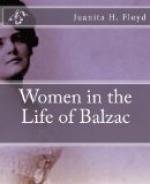“And they talk of the first love!
I know nothing as terrible as the
last, it is strangling.”
The longest and by far the most important of Balzac’s friendships began by correspondence was the one with Madame Eveline Hanska, whose first letter arrived February 28, 1832. The friendship soon developed into a more sentimental relationship culminating March 14, 1850, when Madame Hanska became Madame Honore de Balzac. This “grand and beautiful soul-drama” is one of the noblest in the world, and in the history of literature the longest.
So long was Balzac in pursuit of this apparent chimera, and so ardent was his passion for his “polar star” that the above words of Quinola may well be applied to his experience. So fervent was his adoration, so pathetic his sufferings and so persistent his pursuit during the seventeen long years of waiting that Miss Betham-Edwards has appropriately said of his letters to Madame Hanska:
“Opening with a pianissimo, we soon reach a con molto expressione, a crescendo, a molto furore quickly following. Every musical term, adjectival, substantival, occurs to us as we read the thousand and odd pages of the two volumes. . . . Nothing in his fiction or any other, records a love greatening as the tedious years wore on, a love sovereignly overcoming doubt, despair and disillusion, such a love as the great Balzac’s for l’Etrangere.”
Their relationship from the beginning of their correspondence to the tragic end which came so soon after Balzac had arrived “at the summit of happiness,” has been shrouded in mystery. This mystery has been heightened by the vivid imagination of some of Balzac’s biographers, where fancy replace facts.
Miss Katherine P. Wormeley denies the authenticity of some of the letters published in the Lettres a l’Etrangere, saying:
“No explanation is given of how these letters were obtained, and no proof or assurance is offered of their authenticity. A foot-note appended to the first letter merely states as follows: ’M. le vicomte de Spoelberch de Lovenjoul, in whose hands are the originals of these letters, has related the history of this correspondence in detail, under the title of Un Roman d’Amour (Calmann Levy, publisher). Madame Hanska, born Evelina (Eve) Rzewuska, who was then twenty-six or twenty-eight years old, resided at the chateau of Wierzchownia, in Volhynia. An enthusiastic reader of the Scenes de la Vie privee, uneasy at the different turns which the mind of the author was taking in La Peau de Chagrin, she addressed to Balzac—then thirty-three years old, in the care of the publisher Gosselin, a letter signed l’Etrangere, which was delivered to him February 18, 1832. Other letters followed; that of November 7 ended thus: ’A word from you in the Quotidienne will give me the assurance that you have received my letter, and that I can




